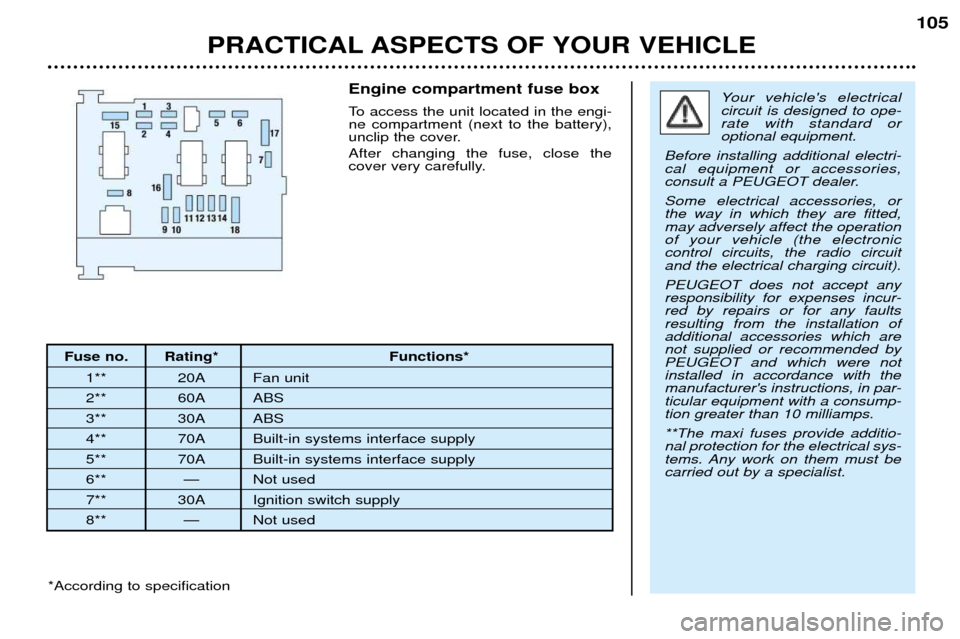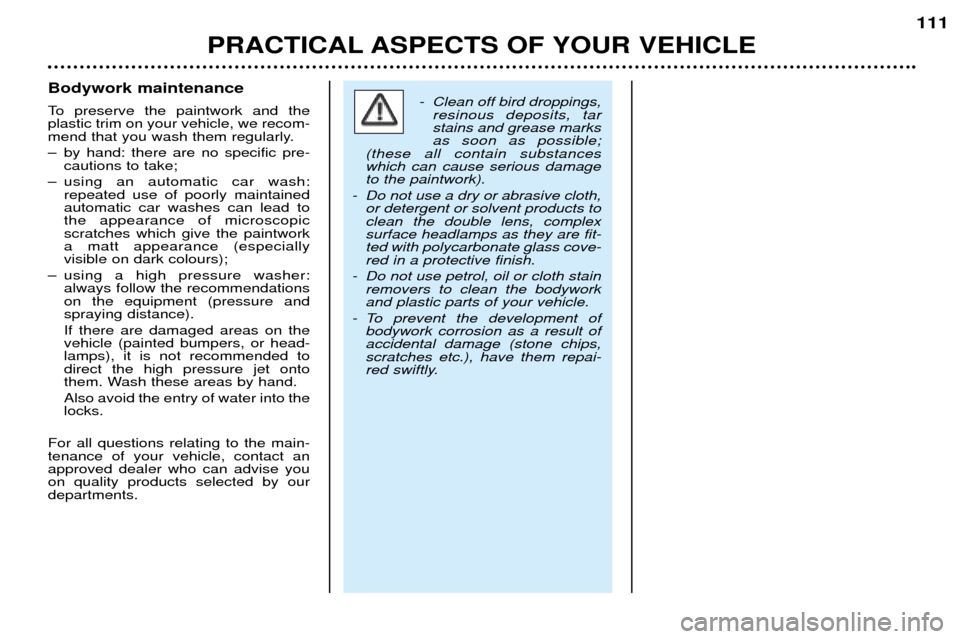ESP Peugeot 206 CC 2001.5 User Guide
[x] Cancel search | Manufacturer: PEUGEOT, Model Year: 2001.5, Model line: 206 CC, Model: Peugeot 206 CC 2001.5Pages: 123, PDF Size: 2.88 MB
Page 86 of 123

YOUR 206 CC IN DETAIL
86
Operating programmes
You have a choice of three operating pro- grammes:
Ð Autoadaptive (normal).
Ð Sport.
Ð Snow.One press on button
Aor Bwill select
Sport or Snow respectively. The selec- tion is displayed on the instrumentpanel. Pressing the button a secondtime will return to the autoadaptive(normal) programme. Autoadaptive programme (normal) Gear changes are carried out on the basis of various parameters, such as:
Ð driving style,
Ð road characteristics,
Ð vehicle load.The gearbox continuously scans the
different programmes in the memoryand selects the one most suitable forthe driving conditions at any givenmoment. Sport programme The Sport programme automatically favours more dynamic driving. Snow Programme In position
D, the Snow programme
provides smooth driving suited to slip- pery roads in order to improve traction
and stability. Starting is in 2nd gear
and changing down is at low enginespeeds. Special operating features
Ð During prolonged braking, the gearbox changes down automatically, so as to
provide efficient engine braking.
Ð If you take your foot off the accele- rator suddenly (when you are takenby surprise, for example), the gear-box will not change up, so as to
improve safety.
Ð When the engine is cold, the gear- box automatically selects a specialprogramme that enables the engineto reach its ideal temperature more quickly in order to decrease pollu-tion.
Kickdown For immediate maximum acceleration
without touching the gear lever, press theaccelerator pedal down as far as it will go.The gearbox will change down automati-cally or stay in the gear selected, up tomaximum engine speed.Any disruption of the system is signalled by the simulta-neous flashing of the Sportand Snow lights on the ins-
trument panel. In such a case, thegearbox will operate in downgrade
mode. You may feel a substantialknock when reverse is selected from P
to Ror Nto R(without any risk of
damage to the gearbox). Do not exceed 60 m.p.h. (100km/h).Contact a PEUGEOT dealer without
delay. When the engine is idling with the car
in gear, the car will move even withoutyou accelerating. Do not accelerate while a gear is being
selected, when the vehicle is stationary.
When stationary, have your foot on the
brake pedal when selecting a gear. Do not accelerate in gear with the brakes on. If work needs to be done with the engi- ne running, apply the handbrake andselect position P.
Do not change down to brake on slip-pery roads. Never select position Nwhen the
vehicle is moving.Never engage Por Rif the vehicle is
not stationary.Do not leave children inside the vehicle unsupervised when the engineis running.
Page 109 of 123

PRACTICAL ASPECTS OF YOUR VEHICLE105
Fuse no. Rating* Functions*
1** 20A Fan unit
2** 60A ABS
3** 30A ABS
4** 70A Built-in systems interface supply
5** 70A Built-in systems interface supply
6** Ñ Not used
7** 30A Ignition switch supply
8** Ñ Not used Engine compartment fuse box
To access the unit located in the engi- ne compartment (next to the battery),
unclip the cover. After changing the fuse, close the
cover very carefully.
Your vehicle's electrical circuit is designed to ope-rate with standard oroptional equipment.
Before installing additional electri-cal equipment or accessories,
consult a PEUGEOT dealer. Some electrical accessories, or the way in which they are fitted,may adversely affect the operationof your vehicle (the electroniccontrol circuits, the radio circuitand the electrical charging circuit). PEUGEOT does not accept any responsibility for expenses incur-red by repairs or for any faultsresulting from the installation ofadditional accessories which arenot supplied or recommended byPEUGEOT and which were notinstalled in accordance with themanufacturer's instructions, in par-ticular equipment with a consump-tion greater than 10 milliamps. **The maxi fuses provide additio- nal protection for the electrical sys-
tems. Any work on them must becarried out by a specialist.
*According to specification
Page 115 of 123

PRACTICAL ASPECTS OF YOUR VEHICLE111
Bodywork maintenance
To preserve the paintwork and the plastic trim on your vehicle, we recom-
mend that you wash them regularly.
Ð by hand: there are no specific pre-
cautions to take;
Ð using an automatic car wash: repeated use of poorly maintained automatic car washes can lead tothe appearance of microscopicscratches which give the paintworka matt appearance (especiallyvisible on dark colours);
Ð using a high pressure washer: always follow the recommendationson the equipment (pressure andspraying distance). If there are damaged areas on the vehicle (painted bumpers, or head-lamps), it is not recommended todirect the high pressure jet onto
them. Wash these areas by hand. Also avoid the entry of water into the locks.
For all questions relating to the main-tenance of your vehicle, contact anapproved dealer who can advise youon quality products selected by ourdepartments.- Clean off bird droppings, resinous deposits, tar stains and grease marksas soon as possible;
(these all contain substanceswhich can cause serious damageto the paintwork).
- Do not use a dry or abrasive cloth, or detergent or solvent products toclean the double lens, complexsurface headlamps as they are fit-ted with polycarbonate glass cove-red in a protective finish.
- Do not use petrol, oil or cloth stain removers to clean the bodyworkand plastic parts of your vehicle.
- To prevent the development of bodywork corrosion as a result ofaccidental damage (stone chips,scratches etc.), have them repai-
red swiftly.